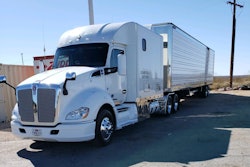This the second of a three-part series to help carriers control, and even reduce, their insurance premiums. Part one covered the basics of how insurers determine premiums. Part three lists key ways fleets can reduce their insurance costs.

Drivers are the lifeblood of your company, even if your balance sheet shows trucks to be the company’s most prized assets. After all, each rig can cost tens of thousands of dollars to purchase and maintain. But without drivers, your trucks will sit idle and loads don’t get delivered. This makes your team your most valuable asset.
And your greatest liability.
 Wade Millward is chief marketing officer, transportation division, of Millward Agency, a family-owned and operated insurance agency in Provo, Utah.
Wade Millward is chief marketing officer, transportation division, of Millward Agency, a family-owned and operated insurance agency in Provo, Utah.Truck drivers share a tremendous responsibility when behind the wheel. The sheer size of a tractor plus its trailer makes any accident a catastrophic event. Because of this, insurance companies are highly sensitive to the drivers you hire. By taking a proactive approach to your hiring, training, and monitoring practices, you can reduce your fleets’ insurance premiums.
Hire right
Reducing your risk in the eyes of an insurance company begins with your hiring practices. Although insurers will run MVRs on each driver, they only tell so much. By expanding your due diligence with each new hire, your company will be more attractive to insurance companies.
Your organization should have a written new-hire procedure documenting your hiring process from application to hire. The process should include:
- License check
- Drug screening
- Written application
- MVR check and review
- Formal, in person interview
- Speak with prior employers
- Review of all driving records
Submit your new hire process along with documented applicant information when soliciting quotations for insurance. Odds are it will be more robust than most applicants, giving you a leg up in securing more competitive terms at lower rates.

Train Right
Hiring the best drivers is only the first step. Keeping your team well trained and up to date on the latest safety regulations will help reduce potential claims. Here too you will want a documented procedure in place that can be provided to insurance companies.
Within your training procedure, include:
- Defensive driving program
- Distracted driving training program
- Pre-inspection / walk-around program
- Securing the truck and trailer program
- Loading and unloading training program
- High risk training program (hazmat, double trailer, auto hauling, etc.)
A robust training program does require a significant time commitment to develop and run on a consistent basis (at least once a quarter). However, not only will you save money on your trucking insurance, you might avoid the biggest expense of all – a large accident claim.
Monitor / Discipline Right
Having strong training programs is only as good as the disciplinary measures you have to back them up. This is where the rubber really meets the road. While insurance underwriters will appreciate formal hiring and training processes, what they really want to know is how you monitor and enforce them.
Because your business is mobile, monitoring your drivers can be a bit of a challenge. But with a combination of old and new technology, you can exhibit your commitment to safety. Here are a few of the most effective monitoring methods:
- Perform ride-a-longs
- Install telematics in each truck
- Regularly pull and review MVRs
- Implement a safe driver incentive program
- Use checklists (i.e. walk around safety checklist)
- Administer written quizzes after each training session
- Deploy an “am I driving safe?” bumper-sticker program
- Conduct regular drug and alcohol screenings (in accordance with state and federal law)
For each monitoring program you have, include the disciplinary actions you will take if drivers violate any of your conditions. The more oversight you have on your drivers, the lower likelihood of an at-fault accident of occurring.
What’s Your Story?
We began our series emphasizing that underwriters want to know your story. When it comes to drivers, make sure you have your hiring, training, and monitoring/discipline procedures clearly spelled out. The details in each will help underwriters see your commitment to safety.
Together, you will have a compelling story to tell. One that will get underwriters excited to write your business as competitive as they can. Couple a comprehensive driver program with the technology we will discuss in our next post and you definitely won’t have just any ol’ story to tell.













